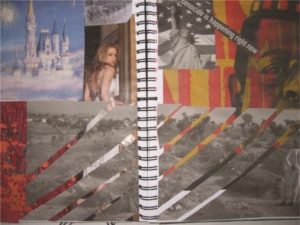
A student’s visual journal entry. Courtesy La Jevic and Springgay.
In 2008, Professors Lisa La Jevic and Stephanie Springgay introduced assessed visual journals into a preservice teacher education course at Pennsylvania State University, University Park.
The course met each week for one semester (16 weeks) for a total of 4 hrs per week. Students were asked “to keep visual journals to reflect on and demonstrate their search for ideas, to document media exploration and artistic decision making and revision, to present research, and to discuss/reflect on implications for classroom practice.” Their visual entries included drawings, paintings, collages, photographs, poetry, and quotes.
Limiting the amount of text allowed in each entry enabled the students, who often hadn’t had a formal art class since their secondary or even primary education, to use visual art as a form of research inquiry, meaning-making, and embodied learning.



Students’ visual journal entries. Courtesy La Jevic and Springgay.
The visual journal was expected to be a work in progress comprising classroom explorations, research materials, handouts, class notes, reflections, homework assignments, and in-class activities and investigations. Once a week, studio time was provided for students to complete in-class art activities. Students were required to complete at least one page per week that investigated separate readings assigned outside of class. The visual journals were routinely examined by students, peers, and the instructor to examine student progress, growth, and understanding. The visual journals were assessed on the fulfillment of the required assignments; experimentation of different materials; demonstration of skill and technique; incorporation of ideas, imagery, and text; and creativity, effort, and criticality.
Lisa La Jevic and Stephanie Springgay. “A/r/tography as an Ethics of Embodiment: Visual Journals in Preservice Education”. Qualitative Inquiry Vol. 14, No. 1 (2008): 67-89. doi:10.1177/1077800407304509
